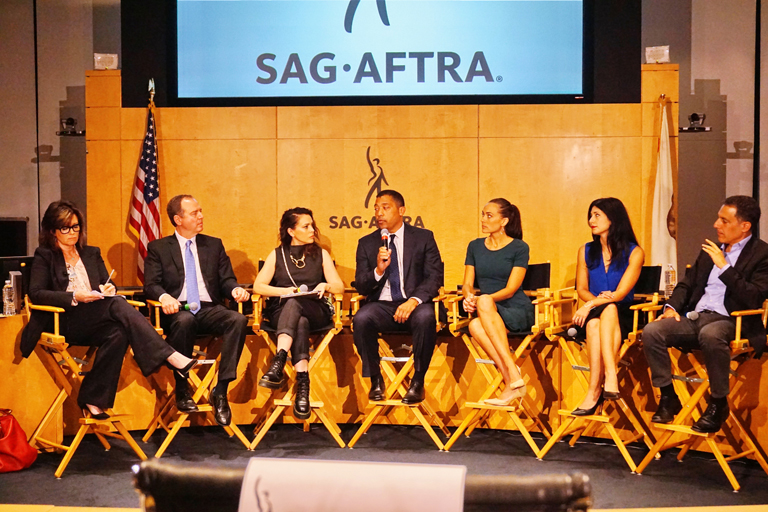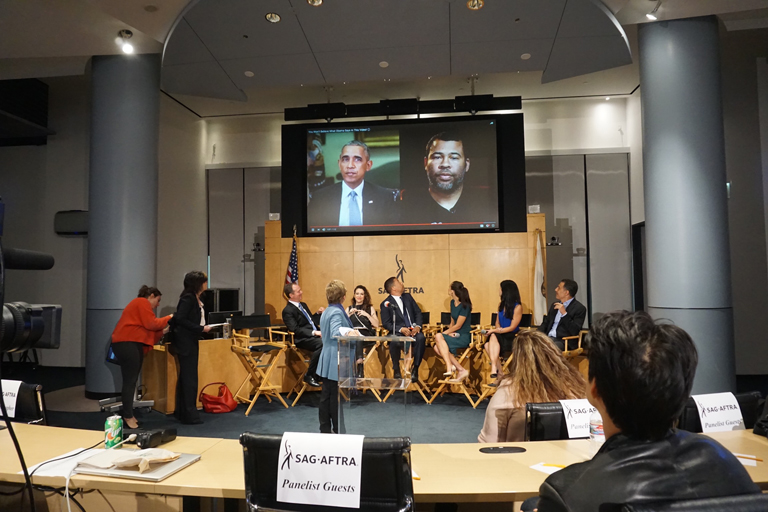
From left are news anchor Colleen Williams, Rep. Adam Schiff, actress Alyssa Milano, SAG-AFTRA National Executive Director David White, actress Heidi Johanningmeier, Cyber Civil Rights lawyer Dr. Mary Anne Franks and Dr. Hany Farid.
By Charly SHELTON
The T-1000 is the evil liquid metal robot from “The Terminator” films that is so human-like that it is nearly indistinguishable from real people. Cylons are the human-like robots that invade the human factions in “Battlestar Gallactica.” Replicants are engineered non-humans poised to take control in “Bladerunner.”
The recurring theme in all the best science fiction properties is of technology being used to imitate humans so that humans can no longer trust what they see to be real. The first step is now being taken to achieve this in the real world.
“Deepfake” videos are starting to surface in which famous people appear to do or say anything the video’s creator wishes. These deepfake videos are real threats – not only to the person who is being faked but also to the world at large.

Several key members of the fight against deepfakes came together this week at the Screen Actors Guild in LA to speak about the realities of the situation and what can be done. Deepfakes, for those unfamiliar, is a catch-all term for any video that falsifies a real person’s likeness so it does something fake and then presents the video as authentic. Jordan Peele created an example video using the face of former President Obama and replacing his mouth digitally and, combined with a voice dub, the President appeared to say things that he would never say in public. This video went viral and was made as an educational tool to show the power of deepfakes and the danger they pose. Because once something is out there, it’s out there forever.
“When you talk to psychologists about this, they will tell you that even if you were later persuaded that the video you’ve watched was a forgery, you will never completely shed the lingering negative impression of the person,” said Representative Adam Schiff at the SAG summit. “So your brain will tell you, ‘I shouldn’t hold it against Joe Biden or Donald Trump or Bernie Sanders or Elizabeth Warren because that video I saw that went viral I now know to have been faked; but I cannot shake the feeling that that person is … fill in the blank.’ So part of the damage is done when you see or you hear it. This is really what has me so concerned about how this technology may be abused in the context of the political process.”
Deepfake videos come in three styles. A lip-sync deepfake is when a person’s head and face are real with only the mouth being replaced, as Peele did for President Obama. Then there is a face swap video in which someone’s face is swapped onto another body, a technique often used in films for stunts or nude scenes that make it look like that person is actually performing the action. Then there is the most damaging – a “puppetmaster” video. These are essentially motion capture in which a person’s body is scanned and made into a puppet that can be manipulated by an actor, like Andy Serkis puppeting the digital Gollum in “The Lord of the Rings.” But instead of building a digital Gollum, it’s a digital Bernie Sanders, for example.
“What scares me about technology is the reach. The reach is phenomenal. The global reach of it – that I can post something online and I can touch more than half the people in the world. There’s nothing like that power. I think for a long time people underestimated the power of the internet because they thought there’s the digital world and the visible world and the two were somehow separated,” said Hany Farid, professor of digital forensics and human perception at UC Berkeley. “Now we’re realizing that what we do in the digital world has an impact in the physical world. When people read fake news accounts about a child sex ring in the basement of a Washington pizzeria, the cops show up there with a gun. There are real world consequences to what we’re seeing online.”
So if someone posing as Jeff Bezos said there is a run on Amazon stock, the market could suffer before the fake video is reported and removed. Or someone posing as Donald Trump could announce that nuclear weapons have been launched at North Korea and that country may retaliate before the home server is found and cut off. Additionally, once a deepfake video is online, it can be downloaded and reshared millions of times a minute. The reach and the speed are inconceivable.
Next week, we will take a deeper look into deepfake technology and what can be done to slow its growth.
